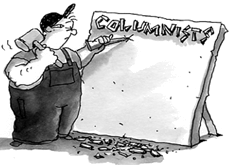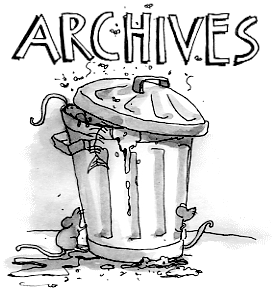The show must go on
 Procrustes •
Procrustes •  Thursday, January 24, 2013
Thursday, January 24, 2013 A post-Dysian world ... Justice Peter Young shows the way ... Veil piercing ... The slipperiness of legislative intention ... "Purpose" is the empty vessel into which judges can pour their own meaning ... Procrustes takes his pills
 Oh gods that be, how we'll miss him!
Oh gods that be, how we'll miss him!
Only 34 more sleeps, children, until Dyse walks off into the post-judicial wilderness.
Will he go back to teaching, as (you are old, Father William) Gummow has, or just into lucrative mediation as per McHugh, once J?
But, miss him we shall: the Shirt of Nessus, the Abbe Sieyes and on the classical allusions flowed, while the historical parade performed to our endless entertainment, or perhaps puzzlement.
Only last month Pope Leo X got a guernsey in a judgment that His Holiness shared with the Caudine Forks and the Samnite Yoke: see The Public Service Association and Professional Officers' Association Amalgamated of NSW v Director of Public Employment.
For those struggling with your pre-Imperial Roman narrative, the Wikipedia entry for the Caudine Forks suggests a pyrrhic defeat at the hands of the Samnites for the then Republic in the 4th century BC.
What little gems lie in store in the remaining days? Anticipation is tempered by the impending loss.
Retired Justice Peter Young showed the way in best equity bar tradition - the show must go on, and so it did after his resignation last April, plus ca change.
He has gone back to sitting as a trial (acting) judge, editing the ALJ and any other legal tasks that come to hand.
Blessedly, equity bar attitudes never die, and soon after retirement, P.W. Young QC as editor of the ALJ wrote a case note decrying recent wimpishness among English judges who had taken to piercing the corporate veil, i.e. letting the unwashed graze on the protected side of the line of incorporation.
His Acting-H was able to write:
"The doctrine of the corporate veil is in force in Australia. The question of piercing does not often arise."
Your correspondent was gob-smacked.
 Peter Young - showing the way
Peter Young - showing the way
The question of corporate piercing does not often arise in this country because Young J, or CJ in Eq or JA (and now presumably AJ), along with those of like mind, have always seen off the moralists and do-gooders seeking to get behind the legal identity of incorporated bodies and find the perpetrators of whatever dastardly deeds have been done, and make them responsible.
One of the cases Young QC proffered as evidence of the health of the corporate veil in this country was one he decided in 1986, his first year on the bench.
That veil piercing does not often arise, was dropped as a throwaway line in the wake of two decades of litigation with James Hardie and CSR as they attempted to hive-off their assets to corporate bodies that would not bear the brunt of the litigation for asbestos injury and death, leaving the liabilities in a corporate, inadequately funded, shell.
As The Financial Review noted in November, in respect of Julie Bishop's work in asserting the corporate veil to protect her client CSR from asbestos claims: "Hardly very edifying."
The NSW government had to set up a commission run by David Jackson QC to get to the truth of what James Hardie was up to and the report in 2004 was not pretty reading, evidencing as it did a ruthless use of the corporate veil to protect the interests of shareholders at the expense of asbestos victims as creditors.
Thank heavens the money changers and Pharisees have been driven out of the temple. Now it's been left, at least in this country, in the benign care of the equity division.
Dear me, what an outburst - and the only response is to be patronised by equity barristers.
However, while I was taking my pills, I found myself reading Lord Watson in Salomon's case (go back to the basics).
Addressing the Companies Act of 1862, the old boy intoned:
"'Intention of the legislature' is a common but very slippery phrase, which, popularly understood, may signify anything from intention embodied in positive enactment to speculative opinion as to what the legislature probably would have meant, although there has been an omission to enact it."
These sentiments come like a dirge from the grave as, well over a century later, the Commonwealth parliament chose to revamp s.15AA of the Acts Interpretation Act, so that it now reads:
"In interpreting a provision of an Act, the interpretation that would best achieve the purpose or object of the Act (whether or not that purpose or object is expressly stated in the Act) is to be preferred to each other interpretation."
Parliament seems to have squared Lord Watson's circle for him. But fear not, as Dyse noted in Momcilovic in 2011, quoting the Federal Court on the not entirely different predecessor to the current s.15AA (and one that contained the reference to whether or not purpose was expressly stated in the Act):
"The section is not a warrant for redrafting legislation nearer to an assumed desire of the legislature. It is not for the courts to legislate; a meaning, though illuminated by the statutory injunction to promote the purpose or object underlying the Act, must be found in the words of parliament."
In Momcilovic the High Court was grappling with s.32 of the Victorian Charter of Human Rights and Responsibilities Act, that section being the linchpin between the listed rights and how they are to impact on the interpretation of other legislation - the section also contains a reference to legislative purpose.
 Heydon: unburdened his concern
Heydon: unburdened his concern
Noting that the attorney general's reference to the traditional function of the courts in interpreting statutes was "Delphic", Dyse finally unburdened his real concern as to the distinction between the search by a court for statutory "meaning" as opposed to "purpose", reflecting on the "gap between 'purpose' and 'interpretative meaning', by which 'purpose' controls 'interpretation' rather than merely being a reflection of it."
"In effect s.32(1) permits the court to disregard the express language of a statute when something not contained in the statute itself, called its 'purpose', can be employed to justify the result the court considers proper. The wider the gap, the more 'purpose' is an empty vessel into which particular judges can unrestrainedly pour their own wishes."
Ten years ago the other Great Dissenter referred to the courts having to "give effect to the purpose of the lawmaker, ascertained by reference to the language in which that purpose is expressed".
In the light of revamped s.15AA, with its insistence on preferring a purpose driven interpretation at the expense of alternative interpretations, is the ascertainment of purpose now restricted to the language used by parliament?
The Explanatory Memorandum gives no clues. The search for purpose is now mandated to go beyond the express words used by parliament.
Will the empty vessel of purpose now stretch to Hansard and onto ministerial press statements?
The possibilities for attack on Diceyan (and Dysian) theory open before the judiciary. Purists in the profession may well tremble.









Reader Comments